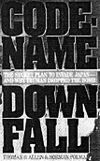 Code Name Downfall, by Normal Polmar and Tom Allen, Simon & Schuster, 351 pp, $37.50, 1995
Code Name Downfall, by Normal Polmar and Tom Allen, Simon & Schuster, 351 pp, $37.50, 1995
This book is a study of the decision to invade Japan, in light of the controversy involving the dropping of the atomic bomb. Polmar and Allen examine the many arguments and topics in a systematic and thorough manner, always referring to documentary sources.
It starts out slow, with chapters describing the various war plans involving Japan, the outbreak of WW II, and so on. Although well-written, the narrative of Pearl Harbor and the Doolittle raid are best skipped unless you are completely unfamiliar with the events described. In fact, you can probably skip the first two chapters. They are meant to give you perspective, but they give it from a little too far back. The good stuff starts when they start talking about airpower and the strategic bombing of Japan in chapter three.
The emphasis throughout is on the damage done to Japan by the bombing, and the casualties we suffered taking Japan's island bases. The landings at Tarawa, Saipan, Iwo, and many others are discussed in order to show their impact on US war planning, on the public, and on the American political process. For example, they describe the outcry after Tarawa. A thousand men killed in a single short battle was a shock the American people weren't ready for. Like Shiloh, it made everyone realize that the cost of victory would be high.
Polmar and Allen trace the war against Japan at the strategic level, as island garrisons are conquered while Japan herself is pounded from the air. Very soon after the tide turns, the realization builds that Japan herself will have to be invaded in order to finally defeat her. They show how the realization grows from a far-off planning goal to a full-fledged assault, with a jump-off date and ships and troops massing when the bomb was dropped.
The authors make it clear that when Truman came in (and they cover his sudden arrival in the Presidency nicely) the bomb was a true unknown, and the invasion of Japan was a sure thing. He made no decision about its use until after it was proven to work, and then he basically decided to use it in case it would hasten the surrender. If it didn't, the invasion, which was only six weeks away, would take place as planned.
And oh, by the way, if the first two bombs had not convinced the Japanese to surrender, the US planners were sure they could have about fifteen weapons ready to use by the time of the first landings on Kyushu. The tentative plan was to use three for each beachhead.
Many parallels are drawn between the invasion of Germany and the potential invasion of Japan. After all, the Germans fought to the bitter end, and didn't surrender until Berlin had fallen and Hitler was dead. The Japanese, with their fanatical mindset against surrender, would fight at least that hard. Their depiction of a enemy almost hysterically dedicated, not to winning but to dying, is chilling but fully consistent with many other sources. After Okinawa, every Japanese soldier, sailor, and airman, and every piece of equipment was considered a suicide weapon. Conventional fighting was completely replaced by a kamikaze ethic.
They provide many examples of Japanese rhetoric of the time, and nowhere is there the expected, "Fight hard, fight smart, and win." Battlefield victory became almost a secondary goal, after death in battle. From the beginning of 1945 and on, Japanese strategy was incapable of winning the war, only of causing wholesale slaughter.
It has a fascinating picture of the Japanese government in the last days of the war, especially after the fall of Okinawa through the dropping of the two bombs and the surrender. Even after Nagasaki, the military wanted to fight on. The Emperor, in a nearly unprecedented action for a figurehead ruler, ordered the government to accept the Potsdam declaration, and was almost overthrown as a result. The accounts of the attempted coup and the nail-biting on the Allied side are fascinating.
BT
Back to The Naval Sitrep #6 Table of Contents
Back to Naval Sitrep List of Issues
Back to MagWeb Master Magazine List
© Copyright 1999 by Larry Bond and Clash of Arms.
This article appears in MagWeb (Magazine Web) on the Internet World Wide Web.
Other military history articles and gaming articles are available at http://www.magweb.com